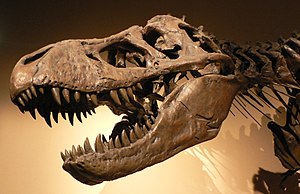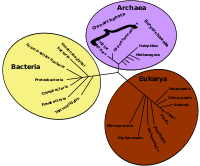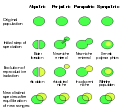Portal:Evolutionary biology
Introduction
Selected article - Lemurs, primates belonging to the suborder Strepsirrhini which branched off from other primates less than 63 million years ago, evolved on the island of Madagascar, for at least 40 million years. They share some traits with the most basal primates, and thus are often confused as being ancestral to modern monkeys, apes, and humans. Instead, they merely resemble ancestral primates. Lemurs are thought to have evolved during the Eocene or earlier, sharing a closest common ancestor with lorises, pottos, and galagos (lorisoids). Fossils from Africa and some tests of nuclear DNA suggest that lemurs made their way to Madagascar between 40 and 52 mya. Other mitochondrial and nuclear DNA sequence comparisons offer an alternative date range of 62 to 65 mya. An ancestral lemur population is thought to have inadvertently rafted to the island on a floating mat of vegetation, although hypotheses for land bridges and island hopping have also been proposed. The timing and number of hypothesized colonizations has traditionally hinged on the phylogenetic affinities of the aye-aye, the most basal member of the lemur clade. (Full article...)General images -The following are images from various evolutionary biology-related articles on Wikipedia.
Selected picture - Tyrannosaurus rex skull at Palais de la Découverte in Paris. Did you know... -
CategoriesRelated portalsTasks you can do
Related topicsWikiProjectsWikiProjects connected with biology: A complete list of scientific WikiProjects can be found here. See also Wikispecies, a Wikimedia project dedicated to classification of biological species. Associated WikimediaDiscover Wikipedia using portals |












![Image 11A covalent adduct between the metabolite of benzo[a]pyrene, the major mutagen in tobacco smoke, and DNA (from Mutation)](http://upload.wikimedia.org/wikipedia/commons/thumb/d/d8/Benzopyrene_DNA_adduct_1JDG.png/87px-Benzopyrene_DNA_adduct_1JDG.png)




































